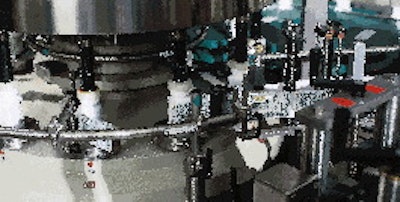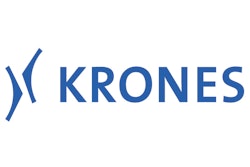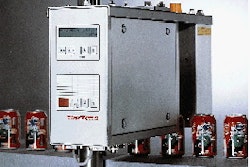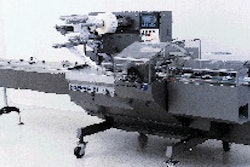When the Nutrilite Div. of Amway Corp. was shopping for a wraparound pressure-sensitive labeler for a new high-speed vitamin packaging line, it needed a machine that would provide the necessary throughput without compromising on registration accuracy. "Our square container makes it fairly difficult to maintain accurate registration and container control," says Richard Taulli, packaging mechanic supervisor at Nutrilite's Buena Park, CA, manufacturing facility, the site of the line. If the label drifts even slightly off-center, for example, the front panel label graphics may bleed over onto the side of the container. "We were looking for perfect placement accuracy," says Taulli. The other critical requirement: the ability to switch between four-panel and five-panel labeling at the touch of a button. Nutrilite has traditionally applied what it internally refers to as a five-panel wrap label: the label starts and finishes on the back panel, with about a 1/2" gap in the center. Of course, there are only four panels on each square high-density polyethylene bottle, but the leading and trailing edges are wiped down separately on the back panel, thus the so-called "five-panel" designation. Five-panel labels were used for both domestic and international production until the U.S. Food & Drug Administration (FDA) issued a rule requiring that label copy be read in a continuous, unbroken direction. That necessitated a label that covers the entire rear panel and meets at the edge where the back and one of the sides meet. Nutrilite refers to this as a standard four-panel label. Nutrilite needed a labeler that could switch effortlessly between four-panel labels for domestic production and five-panel for export. After a thorough search that included in-line and rotary-style labelers, Nutrilite chose a Krones (Franklin, WI) Autocol rotary labeler with a special servo drive modification that permitted just such a switch. "We looked for a company we felt had the most experience in labeling, especially tried and proven in high-production markets," says Taulli. The packaging line, including the labeler, went into operation in September '97. Pinpoint control Instead of using a central cam to drive the rotation of the individual bottle stations, each of the 12 bottle positions on the labeler is driven by its own independent servo motor. The benefit: each servo motor can rotate the bottle plate that holds each bottle by a very precise amount at various points during the labeling cycle. What's more, the machine's PLC can instruct the servo motors to position the bottles at different start and stop points, depending on whether the machine is set for a four- or five-panel label. Taulli explains: "The servo motors are programmed with so many degrees of turn in order for the partially labeled bottle to meet the fixed wiper brush. It's quite a sophisticated piece of equipment compared to the in-line labelers we've used before." Not only does the new labeler permit the ability to switch back and forth between label styles, it provides Nutrilite with the labeling accuracy it sought. "The promise from Krones was accuracy greater than plus or minus one sixteenth of an inch, and really they do better than that," says Bryan Auxier, manager of packaging. "Accuracy is especially important when it comes to the front panel. Our picture, name and logo must always appear on the front panel. With this labeler, we don't have rejects due to drift around the corner." Speed, too The line runs at speeds ranging from 90 to 150 bottles/min, which is double the speed of the line it replaced, with only one additional operator required to augment manual desiccant insertion. On the old line, by contrast, "in order to get any kind of an accurate label placement and keep our drift down, we couldn't run faster than seventy bottles a minute," says Taulli. The line handles six container sizes ranging from 90 to 325 cc. Nutrilite expected to begin using the four-panel label option this month, as artwork for new labels was still being developed at press time. Until now, it has been solely applying five-panel labels. Five-panel labeling works as follows: On the packaging line, by the time bottles reach the labeler, they have been filled, capped (see sidebar) and induction-sealed. At the labeler infeed, they index through a timing screw, and a starwheel transfers the bottles onto individual bottle pedestals, or plates. Though the plates are flat when the bottles are first transferred, the bottles are pressed into a spring-loaded cavity in the center of the plate. The pressure comes from a hold-down mechanism pushing down on the top of the bottle. The cavities in the plates are cut to the specific shape of a given bottle size. The plates and the hold-down mechanism assure positive control of the container. "We get almost perfect container and label control throughout each cycle," says Taulli. Once a bottle is captured, the servo-driven bottle plate pivots 90° to position the bottle properly for receiving the label. A label emerges from a peeler plate and is wiped onto one panel of the bottle with a fixed-position brush. Since all four sides are identical in width and shape, containers do not need to be oriented prior to labeling. Next, the servo motor on a given bottle plate executes a series of 90° pivots to position the bottle properly for wiping the label onto each panel. The turret carries the bottles past fixed brushes on the machines's frame. Once this pivot/wipe/pivot/wipe process is complete, the hold-down mechanism retracts and the spring-loaded cavity releases so that the bottle rests on the plate, and a discharge starwheel removes the container from the plate. Bottles travel downstream for subsequent inspection, shrink bundling and semi-automatic case packing. The labeler takes about 30 minutes to change without tools, including replacing all 12 bottle plates. All parts for each bottle are color coded to aid changeover. "There are really two elements involved in changeover," explains Auxier. "One is the physical changeover, where you change the timing screw, the starwheels and the bottle plates." But changing from a five- to a four-panel label consists of just pushing a button on the machine's control panel, he says. That selects a program in the PLC that communicates a new series of start and stop positions to the drives that control the servo motors. Taulli admits the Krones machine isn't inexpensive. But the machine does an excellent job, and he says the company behind the machine deserves credit as well. "I was especially impressed with the follow-up service and training we had requested. It was all new technology for us, and they have been very responsive and most helpful."



























